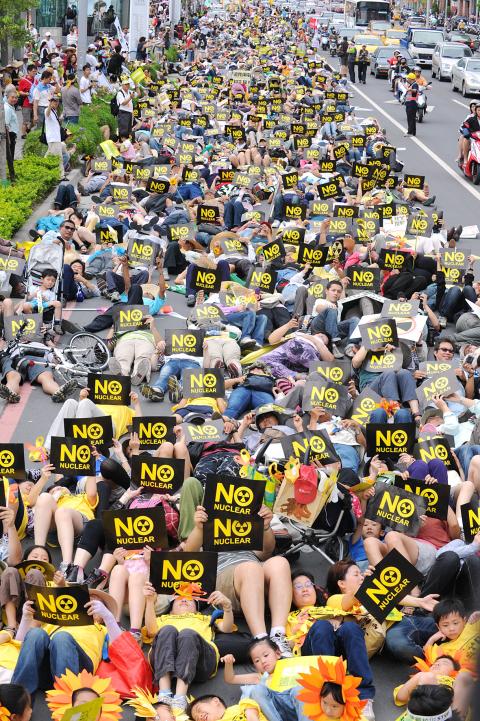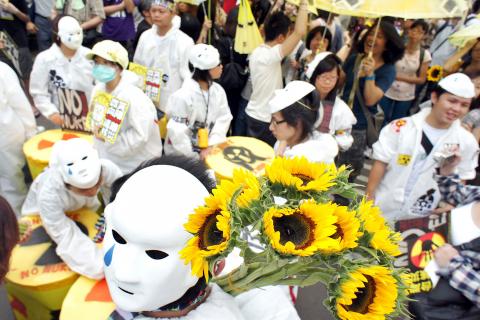|
Anti-nuclear rally draws legions
FLOWER POWER: Organizers said that at least
5,000 people joined the anti-nuclear protest in Taipei City, which was
characterized by a carnival-like atmosphere
By Lee I-Chia / Staff Reporter

People in Greater Kaohsiung
participating in the nationwide “430 Sunflower No Nuke Action” anti-nuclear
power protests lie down on a street yesterday.
Photo: Huang Chih-yuan, Taipei Times

People in Taipei wear masks and
sunflowers during the nationwide “430 Sunflower No Nuke Action” anti-nuclear
protests yesterday.
Photo: CNA
Holding yellow banners and clutching
sunflowers, thousands took to the streets in Taipei yesterday as part of a
nationwide “430 Sunflower No Nuke Action” protest, urging the government to stop
construction of the Fourth Nuclear Plant in Gongliao District (貢寮), New Taipei
City (新北市), and pursue a more sustainable energy policy.
With “smile at the sun, keep away from nuclear disasters” as the theme of the
parade, yellow flowers were picked to symbolize sustainability. Some also held
handmade paper windmills, symbolizing green energy and a bright future without
the fear of a potential nuclear crisis.
The nation’s anti-nuclear movement gained new momentum in the middle of March
after a massive earthquake struck Japan and unleashed a tsunami that damaged the
Fukushima Dai-ichi nuclear power plant, causing radiation to be released, which
has endangered northeastern Japan’s food and water supplies.
The disaster resonated especially strongly in Taiwan because, like Japan, it is
prone to earthquakes that could lead to scenarios similar to those that crippled
the Japanese plant.
People of all ages took part in the carnival-like parade yesterday.
A section of the parade, called the “Keep Away from Nuclear Disaster Division,”
was led by about 20 people holding up a long yellow banner with the words “No
Nukes” written on it, followed by a group of protesters wearing radiation
protection suits to remind people about the potential severity of nuclear
disasters.
Another section was -comprised mostly of students from several universities.
Young people dressed in colorful clothes danced to music as they shouted
anti--nuclear power slogans and paraded through the bustling streets.
“I think the government should replace nuclear power with other safer energy
sources,” said a mother surnamed Chang (張), who stood on the sidewalk with other
parents and children for a short break during the parade.
She said she wanted her daughter, who is in the first grade, to take part in the
parade because they had been taught about nuclear power issues at school, and
her daughter was happy to participate.
A student from an Aboriginal Tao village on Orchid Island (蘭嶼), where a nuclear
waste storage facility is located, said the Tao people believed that nuclear
radiation, which has no form or color, is like evil spirits and must be
banished.
This inspired him to wear a traditional Tao warriors helmet made out of paper to
symbolize fighting off evil spirits.
A 35-year-old woman surnamed Chen (陳) was dressed in a wedding gown and said
that while the government is concerned about the nation’s low fertility rate,
“we don’t want to get married and raise our children in such a dangerous
environment.”
“After the Fukushima nuclear crisis, I think there are some things that are
non-negotiable,” she added.
At one point, the crowd lay on the ground, pretending to be dead, after a
simulated nuclear leakage siren sounded.
The display, called “If that day comes,” symbolized the many people that could
die in Taiwan if a nuclear crisis were to unfold, the organizer said.
Appealing to the government to map out retirement plans for the nation’s three
operational nuclear power plants, to put an end to the construction of the
Fourth Nuclear Power Plant and to create a nuclear-free homeland where everyone
can live without fear of a nuclear disaster, the protesters shouted slogans such
as, “Cherish life, end nuclear power,” and “I want a nuclear-free homeland.”
Their two-and-a-half-hour parade eventually led them to the Presidential Office
on Ketagalan Boulevard.
Two Japanese, Ono Saiko and Oga Ayako, who said they were forced to leave their
homes in Fukushima Prefecture because of the nuclear crisis, joined the parade
in Taipei and shared their thoughts with the crowd.
“The Fukushima nuclear crisis is still going on in Japan; we are not in the mood
to find fault with the cause, but we are facing a problem of how are we to
protect our next generation,” Saiko said.
She said that she hopes people in Taiwan can join forces with people in
Fukushima and take nuclear problems more seriously.
Oga Ayako said she saw “hope and power” in the protest in Taipei, and hopes that
the next time they are in Taiwan it will be a nation free from nuclear threats.
Organizers estimated that at least 5,000 people turned out for the protest in
Taipei, but no police figure was immediately available.
Additional reporting by AFP and CNA
|
![]()
![]()